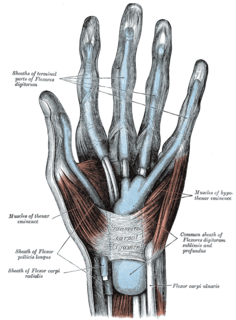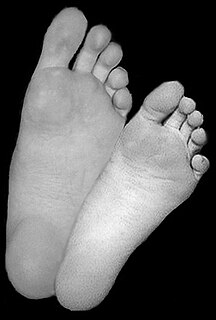
The thenar eminence refers to the group of muscles on the palm of the human hand at the base of the thumb. The skin overlying this region is the area stimulated when trying to elicit a palmomental reflex. The word thenar comes from Greek θέναρ (thenar), meaning 'palm of the hand'.
In human anatomy, extensor carpi radialis brevis is a muscle in the forearm that acts to extend and abduct the wrist. It is shorter and thicker than its namesake extensor carpi radialis longus which can be found above the proximal end of the extensor carpi radialis brevis.

The flexor pollicis brevis is a muscle in the hand that flexes the thumb. It is one of three thenar muscles. It has both a superficial part and a deep part.

The abductor pollicis brevis is a muscle in the hand that functions as an abductor of the thumb.

In human anatomy, the extensor pollicis brevis is a skeletal muscle on the dorsal side of the forearm. It lies on the medial side of, and is closely connected with, the abductor pollicis longus.

The extensor digitorum brevis muscle is a muscle on the upper surface of the foot that helps extend digits 1 through 4.

The extensor hallucis brevis is a muscle on the top of the foot that helps to extend the big toe.

Missa brevis is Latin for "short Mass". The term usually refers to a mass composition that is short because part of the text of the Mass ordinary that is usually set to music in a full mass is left out, or because its execution time is relatively short.

The flexor digiti minimi brevis is a hypothenar muscle in the hand that flexes the little finger at the metacarpophalangeal joint. It lies lateral to the abductor digiti minimi when the hand is in anatomical position.

The sole is the bottom of the foot.

The Toyota Brevis is a former mid-sized luxury sedan introduced in May 2001, that was sold only in Japan.

Karenia is a genus that consists of unicellular, photosynthetic, planktonic organisms found in marine environments. The genus currently consists of 12 described species. They are best known for their dense toxic algal blooms and red tides that cause considerable ecological and economical damage; some Karenia species cause severe animal mortality. One species, Karenia brevis, is known to cause respiratory distress and neurotoxic shellfish poisoning (NSP) in humans.
Crossotini is a tribe of longhorn beetles of the Lamiinae subfamily. It was described by Thomson in 1864.
Mycerinus is a genus of longhorn beetles of the subfamily Lamiinae.
Mycerinus dorcadioides is a species of beetle in the family Cerambycidae. It was described by Audinet-Serville in 1835.
Mycerinus limbatus is a species of beetle in the family Cerambycidae. It was described by Kolbe in 1894.
Mycerinus multilineatus is a species of beetle in the family Cerambycidae. It was described by Stephan von Breuning in 1936.
Mycerinus punctiventris is a species of beetle in the family Cerambycidae. It was described by Kolbe in 1893.
Mycerinus subcostatus is a species of beetle in the family Cerambycidae. It was described by Kolbe in 1894.











